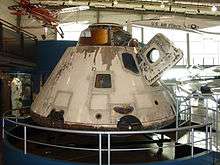Frontiers of Flight Museum
Coordinates: 32°50′33″N 96°50′07″W / 32.8424°N 96.8353°W

The Frontiers of Flight Museum is an aerospace museum located in Dallas, Texas. The museum was founded in November 1988 by William E. Cooper, Kay Bailey Hutchison and Jan Collmer.[1] Originally located within a terminal at Dallas Love Field, the museum now occupies a 100,000-square-foot (9,300 m2) building at the southeast corner of Love Field on Lemmon Avenue.[1] The Museum is an affiliate within the Smithsonian Affiliations program.[2]
Aviation historian George E. Haddaway promoted the founding of the museum subsequent to donation of his extensive personal collection of aviation history books, journals, photographs and archives to the University of Texas at Dallas as the nucleus of one of the world's finest aviation collections, the History of Aviation Collection.[3]
The museum features an extensive collection of aviation history artifacts and vehicles, and focuses on the history of aviation and space exploration with an emphasis on the role of the Dallas/Fort Worth area. Exhibits include the Apollo 7 Command Module, a World War I Sopwith Pup biplane, artifacts from the German airship Hindenburg and other airships, and over 200 World War II aircraft models.
Aircraft on display
The Frontiers of Flight Museum's collection of aircraft includes:[4]
- Bell 47
- Bell TH-1L Iroquois
- Bell UH-1D Iroquois
- Boeing 737-200 nose section, Southwest Airlines livery.
- Boeing 737-300 registration N300SW, Southwest Airlines livery.
- Boeing-Stearman PT-17 Kaydet
- Bücker Bü 133
- Culver Dart GC
- Curtiss JN-4D "Jenny"
- de Havilland DH.82H Tiger Moth
- E-Systems XQM-93A
- Glasflügel BS-1
- Laser 200
- LearAvia Lear Fan 2100
- Learjet 24D
- Lockheed T-33A Shooting Star
- Lockheed Martin F-16B Fighting Falcon
- LTV A-7 Corsair II
- Meyer's Little Toot
- Northrop T-38 Talon
- Piper PA-20 Pacer
- Pitts S-2B
- Republic F-105D Thunderchief
- Ryan PT-22 Recruit
- Sopwith Pup
- Texas-Temple Sportsman (sole surviving example)
- Vought RF-8G Crusader
- Vought V-173 "Flying Pancake"
- Wright Flyer (replica)
Gallery


.jpg)
.jpg) Vought Airtrans (Car #25)
Vought Airtrans (Car #25)
See also
References
- 1 2 Frontiers of Flight Museum site
- ↑ "Frontiers of Flight Museum". Affiliate detail. Smithsonian Affiliations. 2011. Retrieved 16 Jul 2011.
- ↑ Texas Aviation Hall of Fame George E. Haddaway
- ↑ "AIRCRAFT". Frontier Flying Museum. Retrieved: 20 April 2016.
External links
| Wikimedia Commons has media related to Frontiers of Flight Museum. |